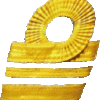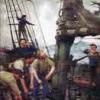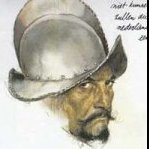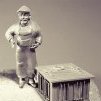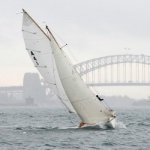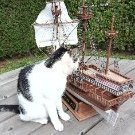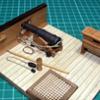MORE HANDBOOKS ARE ON THEIR WAY! We will let you know when they get here.
×
-
Posts
1,553 -
Joined
-
Last visited
Reputation Activity
-
 G.L. reacted to Sailor1234567890 in Young America 1853 by EdT - FINISHED - extreme clipper
G.L. reacted to Sailor1234567890 in Young America 1853 by EdT - FINISHED - extreme clipper
Ed,
Back to the subject of the lovely photo of the top showing the lines led through the fairlead board in the top.... Do you have an image showing a little lower? I'm curious where the lines pass through the shrouds and how they do so as they are clearly outboard of the shrouds and ratlines in that image but we all know they belay below to the pins on the rail inboard of the shrouds.
Thanks,
Daniel
-
 G.L. reacted to michael mott in Bristol Pilot Cutter by michael mott - 1/8 scale - POF
G.L. reacted to michael mott in Bristol Pilot Cutter by michael mott - 1/8 scale - POF
Thanks Pat
Not a lot to show for today, I am thinking of some steel cables for the topmast shrouds so did some experimenting with some Beadalon wire and made 4 new shackles. from some .060 copper wire.
I soldered up a small fixture for drilling the .056 holes through the shackles
The pins were turned from some inexpensive 3/16 brass rod from Home Depot. I am impressed at the free machining quality of this brass, which allowed for me to cut the diameter in one pass, this ensured that the work was supported all the way by the 3/16 section as it was being reduced. I backed out the cutter and cut a shoulder that was .030" larger in diameter, then parted off the pins for drilling the #78 retaining ring hole.
I filed a small flat with a #8 cut file as a land for the drill. which I supported pretty close to the cutting edge.
That's it for today.
Michael
-
 G.L. reacted to michael mott in Bristol Pilot Cutter by michael mott - 1/8 scale - POF
G.L. reacted to michael mott in Bristol Pilot Cutter by michael mott - 1/8 scale - POF
Tim I have spent countless hours pouring over just about every detail of "Integrity" it is a beautifully conceived yacht. and to answer you question about the model I will probably give it away eventually.
Thanks Druxey, I really did not want to go through the motions of making a fourth topmast.
Kees thanks for you kind words
Ab thanks for your words and yes the details are for me, the most fun and challenging part. It again reminds me of Remco's byline that I'm paraphrasing if one treats every part as a model in its own right one will get there eventually.
Steve yes this will be a great experience hopefully a lot of fun too.
Thanks Dowmer I was just too tired to remember last light.
I also forgot to add the pictures of the new pin rail that is almost complete. it is made from fir and i was able to get one more pin in by just squeezing them a 1/2 inch closer together. Scale that is of course.
I will put a small brass cap on the tops of the uprights and round off the center part of the extensions that come through the rail.
Michael
-

-
 G.L. reacted to michael mott in Bristol Pilot Cutter by michael mott - 1/8 scale - POF
G.L. reacted to michael mott in Bristol Pilot Cutter by michael mott - 1/8 scale - POF
Thanks for all the likes and fine comments
More work on the topmast today. first i needed to make the small strop for the shrouds at the top. the first part was to make a ring by unwinding some rope making a length of about 8 1/2 inches long then recoiling itself into a ring.
Once the ring was formed then the thimbles were placed on some new arms for the third hand. and then some "whipping" can't think of the proper term at this time of the night.
Then the top of the topmast was ready for the "harness"
notice the line just below the harness, the result of the error of cutting the slot for the top sheave at 90 degrees to where it should have been cut. I slipped the topmast through the headstock of the Myford after several wraps of masking tape to protect the wood, and cut a rebate about 1/8th inch wide down to 5/32 diameter then cut off the top with the jewelers saw. then bored a shallow hole the same diameter. coated both parts with a thin film of ACC once that had set I pushed the parts together with the sheave fore and aft then gave another shot of ACC to fix it in place.
The shackles are different the small one is new today and the longer one from the bin of shackles.
Once the shrouds were connected, I hoisted the mast again, and laid them over the ends of the spreader to get the position of the lower tackle.
Tomorrow I shall finish the ends or the spreader.
Michael
-
 G.L. got a reaction from tarbrush in Fishing Smack c. 1920 by G.L. - FINISHED - Scale 1/20 - POF - cross-section
G.L. got a reaction from tarbrush in Fishing Smack c. 1920 by G.L. - FINISHED - Scale 1/20 - POF - cross-section
The remaining of the inner planking was done with pitch pine planks. As the hull narrows towards the bow, all planks have to be made individual. Each plank is a bit narrower at one side.
The inner planking is completed
G.L.
Completed projects:
HMS Triton cross section - FINISHED - Scale 1:24
Current projects:
Oostends schipje (Ostend shrimper) - scale 1:20
Cross section Fishing Smack - Scale 1/20, POF, approx. 1920
-
 G.L. got a reaction from KORTES in Fishing Smack c. 1920 by G.L. - FINISHED - Scale 1/20 - POF - cross-section
G.L. got a reaction from KORTES in Fishing Smack c. 1920 by G.L. - FINISHED - Scale 1/20 - POF - cross-section
The remaining of the inner planking was done with pitch pine planks. As the hull narrows towards the bow, all planks have to be made individual. Each plank is a bit narrower at one side.
The inner planking is completed
G.L.
Completed projects:
HMS Triton cross section - FINISHED - Scale 1:24
Current projects:
Oostends schipje (Ostend shrimper) - scale 1:20
Cross section Fishing Smack - Scale 1/20, POF, approx. 1920
-
 G.L. got a reaction from kees de mol in Fishing Smack c. 1920 by G.L. - FINISHED - Scale 1/20 - POF - cross-section
G.L. got a reaction from kees de mol in Fishing Smack c. 1920 by G.L. - FINISHED - Scale 1/20 - POF - cross-section
The remaining of the inner planking was done with pitch pine planks. As the hull narrows towards the bow, all planks have to be made individual. Each plank is a bit narrower at one side.
The inner planking is completed
G.L.
Completed projects:
HMS Triton cross section - FINISHED - Scale 1:24
Current projects:
Oostends schipje (Ostend shrimper) - scale 1:20
Cross section Fishing Smack - Scale 1/20, POF, approx. 1920
-
 G.L. got a reaction from DORIS in Fishing Smack c. 1920 by G.L. - FINISHED - Scale 1/20 - POF - cross-section
G.L. got a reaction from DORIS in Fishing Smack c. 1920 by G.L. - FINISHED - Scale 1/20 - POF - cross-section
The remaining of the inner planking was done with pitch pine planks. As the hull narrows towards the bow, all planks have to be made individual. Each plank is a bit narrower at one side.
The inner planking is completed
G.L.
Completed projects:
HMS Triton cross section - FINISHED - Scale 1:24
Current projects:
Oostends schipje (Ostend shrimper) - scale 1:20
Cross section Fishing Smack - Scale 1/20, POF, approx. 1920
-
 G.L. got a reaction from mtaylor in Fishing Smack c. 1920 by G.L. - FINISHED - Scale 1/20 - POF - cross-section
G.L. got a reaction from mtaylor in Fishing Smack c. 1920 by G.L. - FINISHED - Scale 1/20 - POF - cross-section
That reminds me of the time when I was sailing on an old Agressive class wooden ocean minesweeper as a young officer. In rough sea when the bilges water was in motion, the smell of the bilge filled the entire ship.
G.L.
It is my aim to match your craftsmanship of the Golden Hind.
-
 G.L. got a reaction from yvesvidal in Fishing Smack c. 1920 by G.L. - FINISHED - Scale 1/20 - POF - cross-section
G.L. got a reaction from yvesvidal in Fishing Smack c. 1920 by G.L. - FINISHED - Scale 1/20 - POF - cross-section
The remaining of the inner planking was done with pitch pine planks. As the hull narrows towards the bow, all planks have to be made individual. Each plank is a bit narrower at one side.
The inner planking is completed
G.L.
Completed projects:
HMS Triton cross section - FINISHED - Scale 1:24
Current projects:
Oostends schipje (Ostend shrimper) - scale 1:20
Cross section Fishing Smack - Scale 1/20, POF, approx. 1920
-
 G.L. got a reaction from Mark Pearse in Fishing Smack c. 1920 by G.L. - FINISHED - Scale 1/20 - POF - cross-section
G.L. got a reaction from Mark Pearse in Fishing Smack c. 1920 by G.L. - FINISHED - Scale 1/20 - POF - cross-section
The remaining of the inner planking was done with pitch pine planks. As the hull narrows towards the bow, all planks have to be made individual. Each plank is a bit narrower at one side.
The inner planking is completed
G.L.
Completed projects:
HMS Triton cross section - FINISHED - Scale 1:24
Current projects:
Oostends schipje (Ostend shrimper) - scale 1:20
Cross section Fishing Smack - Scale 1/20, POF, approx. 1920
-
 G.L. got a reaction from BenF89 in Fishing Smack c. 1920 by G.L. - FINISHED - Scale 1/20 - POF - cross-section
G.L. got a reaction from BenF89 in Fishing Smack c. 1920 by G.L. - FINISHED - Scale 1/20 - POF - cross-section
The remaining of the inner planking was done with pitch pine planks. As the hull narrows towards the bow, all planks have to be made individual. Each plank is a bit narrower at one side.
The inner planking is completed
G.L.
Completed projects:
HMS Triton cross section - FINISHED - Scale 1:24
Current projects:
Oostends schipje (Ostend shrimper) - scale 1:20
Cross section Fishing Smack - Scale 1/20, POF, approx. 1920
-
 G.L. got a reaction from mtaylor in Fishing Smack c. 1920 by G.L. - FINISHED - Scale 1/20 - POF - cross-section
G.L. got a reaction from mtaylor in Fishing Smack c. 1920 by G.L. - FINISHED - Scale 1/20 - POF - cross-section
The remaining of the inner planking was done with pitch pine planks. As the hull narrows towards the bow, all planks have to be made individual. Each plank is a bit narrower at one side.
The inner planking is completed
G.L.
Completed projects:
HMS Triton cross section - FINISHED - Scale 1:24
Current projects:
Oostends schipje (Ostend shrimper) - scale 1:20
Cross section Fishing Smack - Scale 1/20, POF, approx. 1920
-
 G.L. got a reaction from michael mott in Fishing Smack c. 1920 by G.L. - FINISHED - Scale 1/20 - POF - cross-section
G.L. got a reaction from michael mott in Fishing Smack c. 1920 by G.L. - FINISHED - Scale 1/20 - POF - cross-section
The remaining of the inner planking was done with pitch pine planks. As the hull narrows towards the bow, all planks have to be made individual. Each plank is a bit narrower at one side.
The inner planking is completed
G.L.
Completed projects:
HMS Triton cross section - FINISHED - Scale 1:24
Current projects:
Oostends schipje (Ostend shrimper) - scale 1:20
Cross section Fishing Smack - Scale 1/20, POF, approx. 1920
-
 G.L. got a reaction from Baker in Fishing Smack c. 1920 by G.L. - FINISHED - Scale 1/20 - POF - cross-section
G.L. got a reaction from Baker in Fishing Smack c. 1920 by G.L. - FINISHED - Scale 1/20 - POF - cross-section
That reminds me of the time when I was sailing on an old Agressive class wooden ocean minesweeper as a young officer. In rough sea when the bilges water was in motion, the smell of the bilge filled the entire ship.
G.L.
It is my aim to match your craftsmanship of the Golden Hind.
-
 G.L. got a reaction from BANYAN in Fishing Smack c. 1920 by G.L. - FINISHED - Scale 1/20 - POF - cross-section
G.L. got a reaction from BANYAN in Fishing Smack c. 1920 by G.L. - FINISHED - Scale 1/20 - POF - cross-section
The remaining of the inner planking was done with pitch pine planks. As the hull narrows towards the bow, all planks have to be made individual. Each plank is a bit narrower at one side.
The inner planking is completed
G.L.
Completed projects:
HMS Triton cross section - FINISHED - Scale 1:24
Current projects:
Oostends schipje (Ostend shrimper) - scale 1:20
Cross section Fishing Smack - Scale 1/20, POF, approx. 1920
-
 G.L. reacted to Baker in Fishing Smack c. 1920 by G.L. - FINISHED - Scale 1/20 - POF - cross-section
G.L. reacted to Baker in Fishing Smack c. 1920 by G.L. - FINISHED - Scale 1/20 - POF - cross-section
Hello,
As always beautiful and precise work.
-
 G.L. reacted to Mark Pearse in Fishing Smack c. 1920 by G.L. - FINISHED - Scale 1/20 - POF - cross-section
G.L. reacted to Mark Pearse in Fishing Smack c. 1920 by G.L. - FINISHED - Scale 1/20 - POF - cross-section
Hi GL
this is going to look fantastic, the staining & timberwork look really authentic, you can almost smell the bilge already.
Mark
-
 G.L. reacted to Ab Hoving in Fish-hooker by Ab Hoving - FINISHED - CARD - after af Chapman - how to scratch-build from paper
G.L. reacted to Ab Hoving in Fish-hooker by Ab Hoving - FINISHED - CARD - after af Chapman - how to scratch-build from paper
Thank you all very much for your encouraging remarks.
Amateur: Yes, I posted this tutorial on a small Belgium forum, which closed its doors a few weeks ago. Thought it was a pity to let it disappear, so I made the translation and tried again. Hope you like it anyway.
Part II
Planking a paper model can be a choice of several possible methods. You can plank with ‘real’ planks, following the run of the real planking of the vessel, you can plank in sections and you can use a combination of the two. Most of the time several layers of planks are used, but I will show the simplest method, with only one drawback, about which more later on.
First of all a few words about the material I use. For the skin a sort of card is used, which in Holland is called ‘hout-bord’ (wood-board) in English probably called -white mechanical pulp board-. It is a yellowish slightly spongy sort of material, much like the coasters used in pubs to place your beer glass on. If you ever bought a Polish kit and purchased the laser-cut parts too, you will know exactly what I mean. It can be bought in different sizes, but I mainly use the 1 mm thick one. The reason to choose this material will become clear in a minute, but I should warn you. This material is inclined to break. Not into two pieces, but it cracks and the crack leaves an ugly angle in the material you surely don’t want. So you will have to carefully pre-bend it with a round stick of sufficient diameter, rolling it in your hand until the final shape is more or less reached and the strip can be glued without stress.
Starting in the mid-ship area it is a simple process to cut a strip of the right width and glue it to the frames, using only one half of the doubled frames to glue to. Thus the next strip will have a decent landing too. Working to both ends of the hull things will get a little bit more complicated: due to the difference in shapes of the frames the strips more and more begin to show a twist. So they have to be cut wider to begin with. The procedure is simple.
Place the bottom of the strip against the keel and the last planked section, allowing for no gaps. Carefully fold the bended strip over the frames, in a way that they touch them entirely on both sides. With a pencil or pen the overlapping side against the already planked area can be marked. Also the height of the bulwarks can be marked. Take sufficient length and width for the strip, because it can easily be trimmed, but hardly enlarged once it is glued on. Cut the excess and place the strip back on its location.
Now there is only side that is left to be shaped. The more often you do this, the better it gets. It is wise for your first efforts to begin cutting a bit wider than necessary. You can always trim later. Make sure that the strip touches the frames everywhere. Any gap will mercilessly show up later.
So in the end we reach the extremities. Now the spongy character of the card will prove to be handy. Cut a piece of card and fit it over the area to be planked. Make sure that it is a few millimeters wider than the gap it will have to cover. Place it in the palm of your hand and use something round to press. I use an iron ball, but I guess a firm spoon will do the job as well. The material will take a roundish shape and with some kneading and pushing and pulling the part will fit and close the remaining opening.
The result so far is rather crude, but have faith, all will end up ship-shape.
As stated earlier the frames above deck-level will have to be removed. Because we slightly perforated them in an earlier stage, this is an easy process: just push them forwards and backwards. They will break and can be removed, flush on deck-level. Prepare a strip wide enough to cover the inside of the bulwarks and glue it on the inside, lining up all the strips of the planking above deck-level. Save the shape of this strip on a separate paper for later finishing.
Here we are with our paper hull completed and more or less in shape.
Not really. The drawback of this type of planking is that angles in the shape of the hull are visible and we don’t want them. It is called ‘the hungry-horse-effect’, looking like the ribs of a neglected horse. So here comes the dirty part of this method. Putty has to be applied all over the hull and sanding is the only way to produce an acceptable shape. Don’t do this in-doors where your wife rules over the tidiness of the house. Your marriage will definitely grind to a halt and that might not be your intention. But applying putty can be done outside the house, as can sanding. It looks like a lot of work, but I doubt if it will take more than an hour all together.
The trick is to do this in shifts. Apply a first layer of quickly drying putty. Use a flexible piece of card or plastic to cover the flat areas between the seams and as little as possible on the seams themselves. Try to follow the curves of the hull. Wait at least overnight until it is thoroughly dry and sand. Use a flat piece of wood and a curved one to wrap the sandpaper in. A few minutes of sanding will be enough to get your first result. You will not like it as it is. So put on a second layer of putty for finishing, only where necessary. After drying, sand again and mark the spots that are still not satisfying in your opinion. A fourth shift, only applied to places where it is needed will probably finish the job.
Of course this is dirty and on top of that it will take some experience. So there are other, more subtle solutions to the problem of planking. You can for instance work with longitudinal strips and apply several layers of planks on top of each other, combined with some sanding that will finally reduce any unwanted angles to almost nothing. You can also try to shape every section of planking you apply with a variant of the iron ball method: make shallow cuts on the inside of every section where a curve is needed and carefully shape them so that the frames become almost invisible. After that you will still have to plank the ship longitudinally, taking care to narrow the planks towards the bow and use stealers aft. You will end up with a magnificent hull. But that will take experience too. The whole process is about experience, but the method I described is easier if you use the trick I will show you here.
But before I unveil the trick, some more preparations have to be made. First you will have to make the rudder. No problem at all. Glue some layers of card together and take the shape from Chapman’s plan. With a few pieces of wire it can be attached to the stern. No hinges? No, why would you take the trouble of making a working rudder if it will never work anyway? We are making a model that looks like ship, but it still is a model and it will only look like a ship.
Once you reached this point, it is wise to make a stand. I use strips of a beautiful kind of card, used for framing artwork, called ‘ivory-card’. The pictures show what it looks like and your art-supplier can help you out.
With the help of a block of wood of the right height you can run a pencil around the hull to mark the waterline and from there you can draw the run of the wales. This should be done with the utmost of care, taking measurements from the plan. Slightly off-line and the beauty of the hull disappears and leaves you with an inelegant and awful result, so take care. The wales can be made both from card and from plastic styrene. The same goes for the top rail, defining the top of the bulwarks. Now the lines of the hull will become visible and you can judge if a week’s work does pay.
Now the final planking is done. There is a firm in Germany producing self-adhesive foils, called C-D-Fix. They sell all sorts of decorative films like flowers, marble, and a variety of sorts of wood: oak, fir, beech and so on. Some builders use these foils, but I don’t like them, looking too ‘plastic’ to me.I use ‘whitewood’, a white foil with a wood imprint. Here is the address: https://www.amazon.com/stores/page/B9ED20F0-36EF-461D-9741-8F093C72F76F?ingress=0&visitId=9aa24d54-da79-4f8c-ab51-d6af39183894
Simply cut strips of the right width and cover the hull with a natural run of the planking. The material sticks remarkably well to the hull, especially if you heat it a little with a hair-dryer. Where the planks should be bended some more heat does the job. The process of planking is so fast that I don’t even have pictures of it. Here is the result after little more than half an hours work.
Next time we will give the hull it’s color and we will work on the details.
-
 G.L. reacted to AON in 9 Pound Naval Cannon 1786 by AON - FINISHED - 1:12 scale
G.L. reacted to AON in 9 Pound Naval Cannon 1786 by AON - FINISHED - 1:12 scale
Then I started working on the sliding information tray. I made a support bridge piece between the frames, marked the depth, wood rasped and then sanded to the marks. Drilled and inserted the stopper dowel. I didn't get any photos of it until the final assembly.
Marked the location, depth and width on the front frame piece then I cut it down.
The sliding "tray" is a piece of MDF (medium density fiberboard) wide enough for the nameplate and deep enough to have a slotted hole to encapsulate the locking pin in a slotted hole. The pull out handle is made of three strands of 0.031" copper wire twisted together to look like rope. One end of the group of wires was clamped in the vise and the other end in the chuck of my variable speed drill. I ran the drill to twist the wires until I had the look I wanted. The wire was bent and the fiberboard was grooved for the wire to sit into, below the surface so the nameplate would sit flat (no bump). As an added precaution the ends of the wire were bent 90° downwards to fit into holes drilled at the end of each groove so when pulling on the wire it has additional holding power to the MDF. This was assembled and glued together. Then the tray was assembled to the sub-base and tested.
-
 G.L. reacted to flying_dutchman2 in Boyer by flying_dutchman2 - FINISHED - Scale 1:48 - 17th Century Dutch Coastal water freighter by Marc Meijer
G.L. reacted to flying_dutchman2 in Boyer by flying_dutchman2 - FINISHED - Scale 1:48 - 17th Century Dutch Coastal water freighter by Marc Meijer
Started bending to shape the gudgeons and the pinntels. Used CA and glued the gudgeons in place.
Put a 0.66 drill bit in the dremel drill press and proceeded to drill holes into the brass gudgeons.
After that, I took brass nails, cut them in half and nailed them through the gudgeons into the stem.
Marcus
Who came up with the word 'gudgeons'???
-
 G.L. reacted to Jim T in Sharpie by Jim T - Scale 1:16 - SMALL
G.L. reacted to Jim T in Sharpie by Jim T - Scale 1:16 - SMALL
Over the last couple of days I managed to get the Mast Step Locks and Mast Box Log built and fitted. The Mast Step Locks are those little angled pieces between the Mast Box Log and the chines. The only thing, of note, about them is that they needed to be beveled at 9 degrees to fit the angle of the chine. The Mast Box Log needed an angle sanded on the bottom which I'll address below.
The Monograph said that the bottom of the Mast Box Log needed to be sanded at a 4 degree angle to account for the rise in the keelson. However, I measured it to be a 1 1/2 degree angle. It IS 4 degrees as it related to the horizontal level line, but as it relates to the uprising keelson it measures 1 1/2 degrees. More on that in a bit. Anyway I clamped a piece of 3/16" sq stock in a tiny vise and slid the Log over that. Set the table on my (new favorite tool) Byrnes disc sander, angled the table to 1 1/2 degrees, and using the miter gauge as a fence sanded the bottom of the log.
Set the Box Log in place and stuck a piece of 3/16" sq into the hole to simulate a mast and this is what it looks like.
A 4 degree angle would of had the mast leaning forward quite a bit. The plan sheet, that shows the mast, seems to show the mast leaning even more to the rear. I think I'm not going to glue the Mast Box in place at this time In case it needs further adjustment.
Jim
-
 G.L. reacted to michael mott in Bristol Pilot Cutter by michael mott - 1/8 scale - POF
G.L. reacted to michael mott in Bristol Pilot Cutter by michael mott - 1/8 scale - POF
I worked on the topmast today and that led to reading up on the topmast shrouds and so a cross tree was made out of some fine grained Pine.
the first picture shows the new spreaders for the topmast shrouds.
When I machined the hole for the bottom sheave to set up the hoisting rig I did not get the hole right, it was too long ans off centre so I cut a new stick and decided to cut in the sheave slot before shaping it. screw up #2 I made the slot the same length.
I embarked on stick #3 this one from some really nice clear spruce I got the bottom sheave done correctly and then started to shape the topmast.
Using the drafting template for roundness once i got close to the diameter I needed, I began the task of final fitting in order to reach I rolled over the other bench as a platform to stand on.
This made the fitting easier.
The topmast has to rise up high enough for the sheave to clear the bolster and leave enough room for the fid. There were a lot of fitting trials befor the sheave cleared. and I seemed to have a problem nearing the finish, then it occurred to me that I was hitting the ceiling because I had left the topmast a little longer. One i removed about 1/2 inch from the top I was able to hoist the mast high enough.
Feels a bit precarious working up so high.
and an overall shot of the days work.
That's all for now
Michael
-
 G.L. got a reaction from tarbrush in Fishing Smack c. 1920 by G.L. - FINISHED - Scale 1/20 - POF - cross-section
G.L. got a reaction from tarbrush in Fishing Smack c. 1920 by G.L. - FINISHED - Scale 1/20 - POF - cross-section
Part 9: Thick stuff inner planking and inner planking
To determine the height of the deck beam clamps, I lay a lath on top of the wales from one side to the other. Below the lath I hold a 6,7 mm thick spacer and glue the clamp under it.
Under the deck beam clamp come two inner wales. There is a narrow space between the two for ventilation.
The inner thick stuff consists of three oak planks.
The whole of the structural inner planking.
I will leave out some of the hull planking at port side of the model to keep the frames visual, therefore it is now time to stain those frames dark.
G.L.
Completed projects:
HMS Triton cross section - FINISHED - Scale 1:24
Current projects:
Oostends schipje (Ostend shrimper) - scale 1:20
Cross section Fishing Smack - Scale 1/20, POF, approx. 1920


